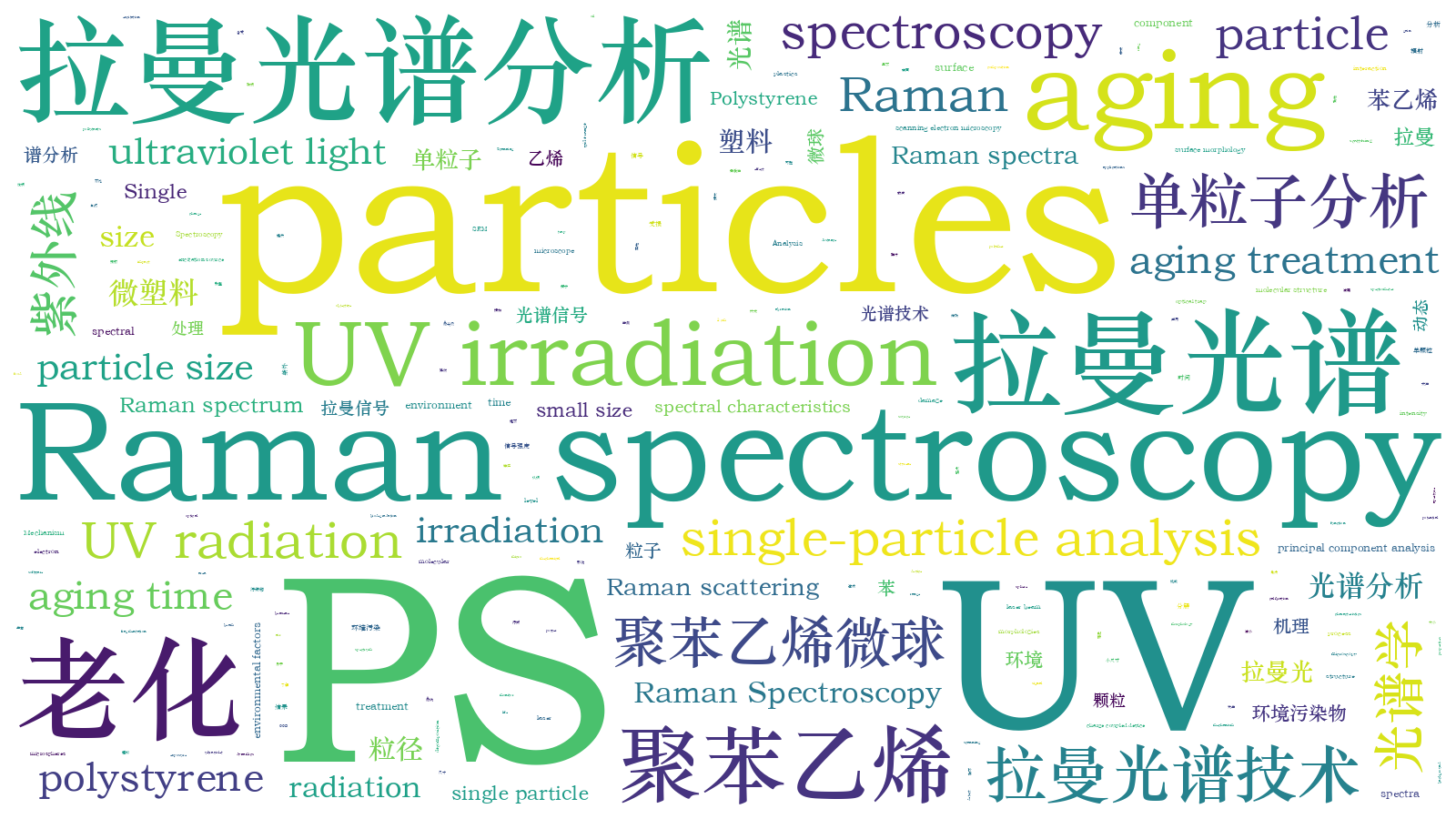单粒子拉曼光谱分析聚苯乙烯微球的老化机理  下载: 1223次
下载: 1223次
Microplastics are new environmental pollutants of great concern. Due to ultraviolet (UV) radiation, biodegradation or mechanical abrasion in the natural environment, the properties such as size, surface morphology, and composition structure change, and microplastics decompose into smaller micro-plastics. However, up to date, the knowledge of the interaction between micron-sized microplastics and UV is still lacking, and the further decomposition of microplastics into smaller debris increases the surface area and makes it easier to adsorb toxic substances. Smaller microplastics are also more easily absorbed by fish and further into the top of the food chain, with a greater potential impact on humans. Polystyrene (PS) is a polymer synthesized from styrene monomers and used in a wide range of applications in industrial production and daily life. Abandoned PS waste and debris in the environment are common. In this paper, the aging process of micron-sized PS plastics is monitored by simulating the UV irradiation of PS microspheres. Single-particle Raman spectroscopy is used to detect the molecular changes after UV treatments, and scanning electron microscopy (SEM) is used to observe the changes in the surfaces and sizes of the particles in order to understand the effect of natural factors on small PS particles and gain the knowledge of the interaction between tiny microplastics and UV irradiation.
The aging process of micron-sized PS is simulated by exposing the particles to UV irradiation. 1, 2, 3 and 5 μm PS beads are evenly spread on sterile slides and air-dried naturally. The slides are then placed under a UV lamp at a distance of 20 cm from the UV lamp (the intensity is measured to be ~ 2.5 μW/cm2). After 1, 2, 3, 4 or 5 d of irradiation, the slides are removed and PS particles are re-suspended in deionized water. The slides without radiation (i.e. 0 d) are used as controls.
Single-particle Raman spectroscopy is used to monitor the changes of individual PS particles before and after the aging treatment. A 780 nm laser beam with a power of about 30 mW is introduced into an inverted microscope and focused with a 100× oil-immersed objective (numerical aperture of 1.30) to form an optical trap for particle capture. The trapping laser also serves as the Raman excitation source, and the Raman scattering from the trapped particle is collected and focused onto a spectrometer, in which the Raman spectrum is recorded via a charge coupled device (CCD). Raman spectra are saved in an ASCII file. The spectra of individual particles are corrected using the calibration function. The background is first subtracted followed by 3-point adjacent smoothing, and then the spectra are imported into Origin and Matlab for the spectral component analysis and the principal component analysis, respectively. Scanning electron microscope is used to observe the surface textures and morphologies of the PS particles. The size is measured using the ImagJ software, and the 40 PS particles per treatment are measured and statistically analyzed.
The Raman signal intensity of PS decreases significantly with the increase of radiation time, especially for small size PS beads (Fig. 1). New bands form at 497 cm-1 and 1286 cm-1 for 1 μm PS and 392, 512, 526, 1367, 1511 cm-1 for 2 μm PS. With the extension of UV irradiation, the peaks at 620, 794, 1602 cm-1 are broadened (e.g. 1602 cm-1 peak became 15501700 cm-1 peak). The main peaks such as the benzene ring breathing peak at 1001 cm-1 are shifted or split into two adjacent peaks. Broad peaks between 460 cm-1 and 560 cm-1 or between 1220 cm-1 and 1320 cm-1 appear (Fig. 3). These changes indicate that the molecular structure of PS is significantly altered by UV irradiation.
SEM shows that the sizes and morphologies of PS particles also change after UV radiation (Figs. 58). Surface breakage and fragmentation are observed, and the particles change from round sphere shapes to less regular shapes. After a longer UV aging treatment, PS particles are deformed and the sizes of PS particles gradually decrease with increasing aging time. Especially, the smaller the particle size, the more serious the damage.
To further understand the aging behavior of microplastics in nature influenced by environmental factors, we investigate the aging mechanism of micron-sized PS particles at a single-particle level by simulating UV radiation. The spectral characteristics of PS particles under particle size and aging time are characterized using the single-particle Raman spectroscopy, and the principal component analysis further reveals the changes in the chemical structures of PS particles under UV exposure. UV radiation is found to damage the structures of PS polymers and PS molecules, and the small particle size, which is more significantly damaged, is degraded to a higher extent. These results suggest that the microplastics with different sizes exhibit different behavioral processes when facing with the same environmental factors, and that small size microplastics are more likely to be decomposed into small particles or small fragments that are potentially more threatening after UV radiation. This study provides new insights into the aging dynamics of microplastics in the environment from the single particle level.
张秀娟, 李翠梅, 彭立新, 刘军贤, 王桂文. 单粒子拉曼光谱分析聚苯乙烯微球的老化机理[J]. 中国激光, 2022, 49(4): 0411002. Xiujuan Zhang, Cuimei Li, Lixin Peng, Junxian Liu, Guiwen Wang. Analysis of Aging Mechanism of Polystyrene Microspheres by Using Single Particle Raman Spectroscopy[J]. Chinese Journal of Lasers, 2022, 49(4): 0411002.







